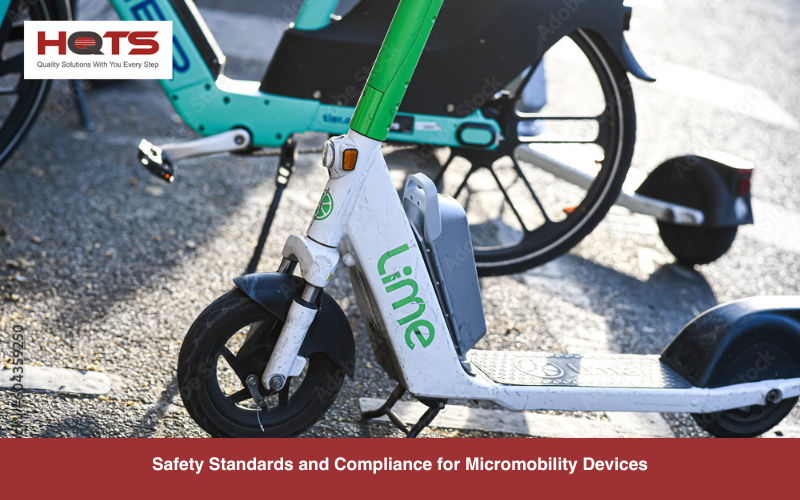Micromobility has emerged as a transformative trend in urban transportation, offering efficient and eco-friendly options for short-distance travel. The global micromobility market has experienced remarkable growth, with its value reaching $49.3 billion in 2021. The market is expected to continue its upward trajectory, projected to reach a staggering $186.2 billion by 2030.
When it comes to electric scooters, e-bikes, bicycles, and skateboards, prioritizing safety is paramount.. In this article, we will explore the world of micromobility safety standards and compliance, shedding light on the regulations that govern these vehicles and the significance of adhering to them.
Understanding Safety Standards
Micromobility devices are subject to a range of safety standards designed to protect riders and promote overall road safety. These standards encompass various aspects such as design, construction, braking systems, lighting, and stability. One of the primary international standards is the ISO/TS 4210-10,, which provides guidelines for the safety of electrically power-assisted cycles (EPACs), followed by ISO 12405 that specifies test procedures for lithium-ion battery packs and systems for use in electrically propelled road vehicles ensuring that these vehicles meet specific safety requirements.
Regional Regulations
In Europe, micromobility devices are subject to regulations set forth by the European Union (EU). The European standards EN 17128 and EN 15194 play a crucial role, outlining safety requirements for EPACs and other light electric vehicles. Compliance with this standard ensures that these devices meet essential safety criteria related to electrical systems, mechanical design, and braking performance.
Additionally, the Machinery Directive (2006/42/EC) and the General Product Safety Directive (2001/95/EC) are fundamental in ensuring that micromobility devices meet safety and quality standards. These directives cover aspects such as risk assessment, labeling, and product traceability, ensuring that manufacturers adhere to strict safety guidelines. Other European regulations concerning micromobility are 2014/30/EU for EMC, 2011/65/EU/ for RoHS, 2014/53/EU (RED) If radio technologies are used in the device.
In the USA, micromobility products are subject to specific safety standards to ensure consumer protection. The Consumer Product Safety Commission (CPSC) plays establishes and enforces these standards. One of the primary regulations is the ASTM F2641-20 Standard Consumer Safety Specification for E-Scooters. This standard covers various safety aspects, including construction, labeling, performance requirements, and testing methods for electric scooters. Additionally, the CPSC encourages adherence to UL Standards such as UL 2849 for e-bikes, UL 2272 Standard for hoverboards.
Battery Safety
As many micromobility devices rely on battery power, ensuring the safety of batteries is paramount. Regulations such as UN 38.3 and IEC 62133 provide guidelines for testing the safety and performance of lithium-ion batteries used in these devices. Compliance with these regulations ensures that batteries undergo rigorous testing for electrical, thermal, and mechanical safety, reducing the risk of malfunctions and accidents.
Labeling and Certification
Proper labeling of micromobility devices is essential to inform users about safety instructions and guidelines. The CE marking is mandatory for these devices sold within the European Economic Area (EEA) and serves as proof of compliance with applicable directives. In the USA micromobility products are expected to meet 16 CFR Part 305 – Energy Labeling requirements. Obtaining certifications from recognized testing laboratories enhances consumer confidence and assures them of the device’s safety and quality.
The Importance of Compliance
Complying with micromobility safety standards goes beyond legal obligations; it underscores a commitment to user safety and responsible manufacturing practices. It ensures that these devices are built with stringent safety measures, reducing the risk of accidents and promoting user confidence. Compliance also fosters harmonization within the industry, creating a level playing field for manufacturers and encouraging the development of safe and reliable micromobility solutions.
As micromobility continues to reshape urban transportation, prioritizing safety standards and compliance is paramount. Manufacturers, regulators, and users must work together to ensure that micromobility devices meet rigorous safety requirements. By adhering to international and regional regulations, implementing proper labeling, and conducting thorough testing, we can embrace micromobility while safeguarding the well-being of riders and pedestrians alike. Contact us today to ensure your micromobility products meet the necessary compliance standards. Our dedicated compliance department at HQTS is well-equipped to assist you in navigating the complexities of micromobility regulations.




